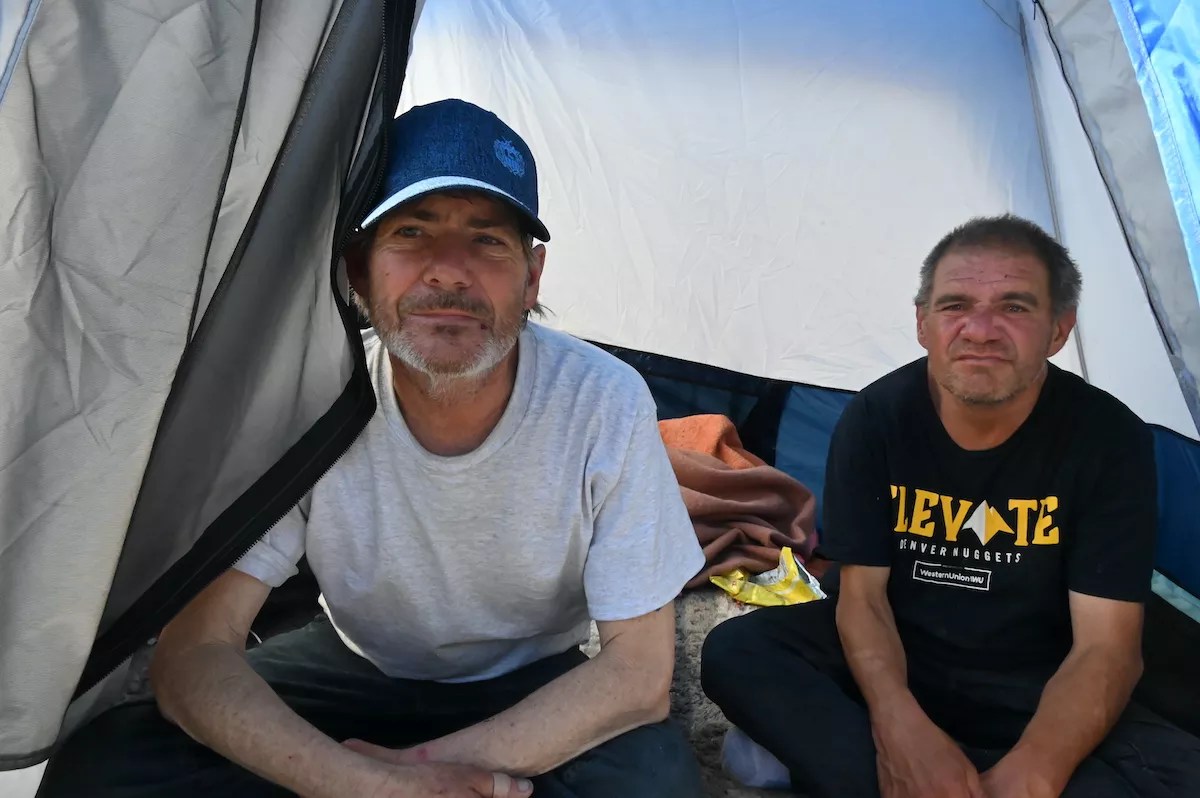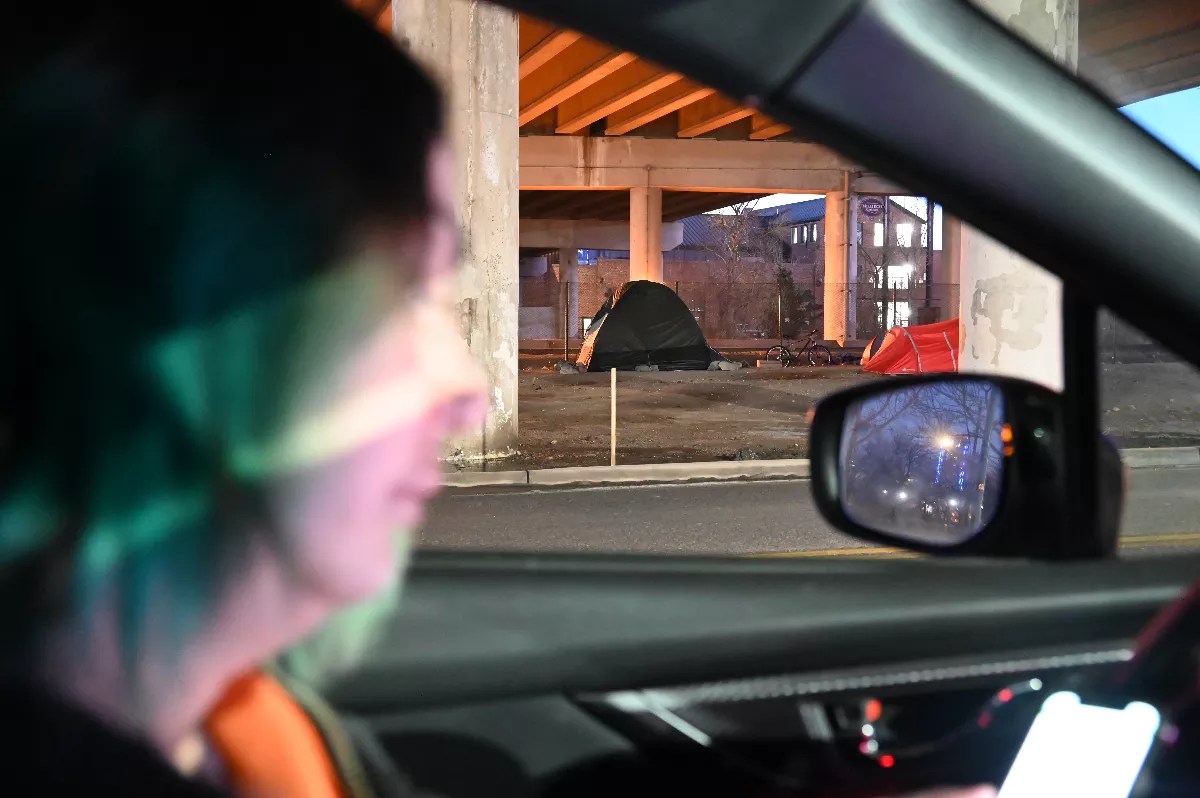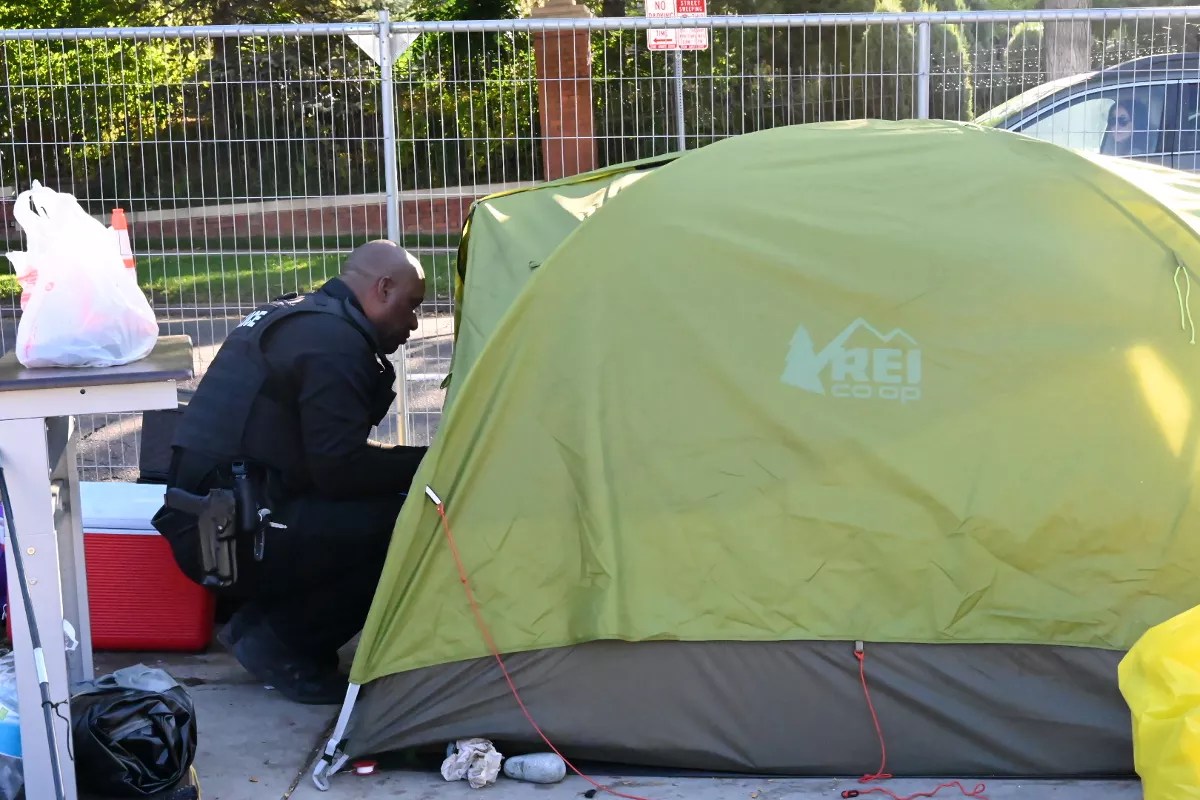
Bennito L. Kelty

Audio By Carbonatix
Mayor Mike Johnston claims Denver is halfway to reaching his goal of solving unsheltered homelessness after the release of the latest Point in Time data, an annual count of homeless residents in shelters and on the streets.
“At the halfway point in the administration, we’re halfway towards the goal,” says Cole Chandler, the mayor’s senior advisor on homelessness resolution. “The mayor set a bold goal to end street homelessness in his first term, and so we feel great that at the halfway point, we’re halfway there.”
Released June 9, the PIT count is federally funded and conducted during one night in January each year. Counties take charge of tallying their homeless populations, often by deploying volunteers to count people who appear to be living on the streets, but the numbers also rely on residents self-reporting that they’re homeless.
On the campaign trail, Johnston promised to make homelessness his top priority. When he took office in July 2023, the first thing he did was declare Denver’s homelessness an emergency; more than 1,400 people were living on the streets and another 4,600 in shelters at the time, according to the 2023 PIT count.
The emergency declaration allowed Johnston to rush contracts through Denver City Council that helped his administration buy properties and hotels to turn into shelters and micro-communities, where people live in shed-like units while looking for stable housing. In the summer of 2024, the administration launched a “street-to-lease” program in which the city connects homeless people with units that accept housing vouchers, enabling people to skip transitional hotel shelters or micro-communities.
Initially, Johnston called his audacious goal of bringing 1,000 people off Denver’s streets House1000, with a timeline of just six months. He has since renamed it All In Mile High (AIMH). According to a city dashboard, the initiative has put nearly 6,000 people into housing in nearly two years, with more than 1,300 coming in through the street-to-lease program.
While the city’s AIMH figures paint an impressive picture, the PIT count for 2025 shows that homelessness in the seven-county metro area – Denver, Adams, Broomfield, Jefferson, Boulder, Douglas and Arapahoe counties – is now at nearly 11,000 people, up from 9,000 in 2023. For Denver alone, the homeless population is now at more than 7,300 people, up from 6,500 people in 2024 and 5,800 in 2023, according to PIT.
Johnston believes the PIT count shows that his strategy is working, but he’s focusing on the unsheltered homeless count, which refers only to people living outside, typically in tents or cars. In 2023, that population was slightly more than 1,400 people; in 2024, it dropped to just under 1,300. The latest PIT count says that only 785 individuals are living on the streets, which is roughly a 45 percent decrease from when Johnston took office.
“Denver is proving that homelessness is solvable so long as we are willing to put in the work to solve it,” Johnston said in a statement when the PIT count was released. “In less than two years, we have gone from a city that swept people from block to block to one that treats people with dignity and delivers real results. This policy is not only morally just but effective.”
Chandler highlights a few other breakthroughs, notably “the largest multi-year reduction in the history of the PIT count in terms of unsheltered homelessness.” He also cites a 30 percent reduction during the last two years in “newly homeless households,” or individuals and families who reported being homeless for the first time.
However, other groups involved in homelessness in Colorado aren’t as easily convinced that Johnston’s on the right path. The federal government relies on the PIT count to decide how to allocate funding for housing and homelessness, but nonprofits and advocates worry that Johnston is going to pin his reputation on the count without solving deeper issues that surveys don’t reveal.
Count Me Out: PIT Blindspots
According to the nonprofit Colorado Coalition for the Homeless, the actual number of homeless residents in Denver is two or three times higher than the PIT count. That count is “a good snapshot” of homelessness, “but it doesn’t tell you the whole picture,” says Cathy Alderman, CCH spokesperson.
“It doesn’t tell you how long it’s taking people to find housing once they’ve entered the cycle of homelessness, it doesn’t tell you what types of services people need to be rehoused, it doesn’t tell you anything about family size or what housing is available,” she says. “It’s dependent on being able to find people. Some people can’t be located or are sleeping in their cars or staying in a motel. We’ve always known that the Point in Time is an undercount…there are many, many more people throughout the year experiencing homelessness, needing services, than there are on a single night in January.”
Still, Alderman says it’s “encouraging” to see the PIT count report more people in shelters instead of on the streets “because it’s much safer, especially in January, when it’s cold.” She also notes that CCH does “applaud the mayor’s initiative” and believes “it will save lives.”
But Alderman is concerned about the lack of affordable housing in Denver: Increases in homelessness have to do with rising rents and eviction rates, she says, and Denver needs to invest in affordable housing to get people out of shelters and “the cycle of homelessness.” Chronic homelessness, when people aren’t able to find permanent housing, is on the rise in Colorado, according to Alderman, who blames the lack of affordable housing.
“There aren’t enough affordable housing resources for people to move out of shelter and move into a long-term solution,” she says. “Until we address that problem, I’m afraid that this is going to continue to happen year over year,”

Sabrina Allie, an employee with the Denver Department of Housing Stability, records a homeless resident living in a tent under an overpass in Sun Valley during the Point in Time count in January 2024.
Bennito L. Kelty
The Common Sense Institute, a Colorado-based research organization, argues that Denver is only putting people into shelters, not getting them out of homelessness. CSI published a report in April that argued Denver’s housing-first approach of sweeping people out of encampments and into temporary housing doesn’t work as well as requiring them to get work to stay in publicly funded housing, an approach that more conservative Aurora is taking.
“CSI acknowledges that the mayor’s approach has been successful in reducing the number of unsheltered homeless individuals,” says CSI homelessness fellow Dustin Zvonek, a former Aurora city councilman hired by CSI earlier this year. “However, as CSI noted in our spring report, this is clearly not reducing the total amount of homeless individuals in Denver. Taking people off of the street and putting them into hotels serving as homeless shelters isn’t the same as reducing homelessness.”
From 2023 to 2025, the number of people living on the streets in Denver dropped by about 600 people, but the number of homeless residents living in shelters increased by more than 2,000 during that same span, PIT counts note. According to the Denver Department of Housing Stability (HOST), 750 people are currently living in AIMH shelters.
Chandler says that Johnston’s goal when he took office was to resolve unsheltered homelessness, not necessarily to have empty shelters, too. He points out that Denver is one of the first cities to start investing in a large-scale solution to homelessness, so CSI has no real way of studying Denver’s success yet.
“It is true that someone staying in a shelter is still considered homeless, but they are no longer considered to be unsheltered, which is what our strategy has been focused on,” Chandler says. “And the reality is this isn’t a debate: There are proven best practices across the country, and we know what works. What has not been done is those strategies have not been invested in at scale, and that’s why you’ve seen unsheltered homelessness continue to rise. We are starting to invest in those strategies at scale.”
Is Fear a Factor?
Johnston has said that as of a few months ago, there were no more large encampments Denver, sometimes noting that migrant encampments are gone, too. Encampments with hundreds of tents and residents used to frustrate residents and businesses in downtown-adjacent areas like La Alma, Five Points and the Ballpark District. Chandler says that the city and Denver Police Deparmtnet have become quick and efficient in taking down tents and small encampments before they grow.
“We’ll have people pop up a tent every now and then, but any time those complaints come in via 311, we’re getting to them within a business day,” Chandler says. “There are no large encampments in the city. We very rarely see complaints of even more than five tents at a time.”
The Housekeys Action Network of Denver, a group that advocates for the city’s homeless population, says that unsheltered residents have felt pressure from the police. Terese Howard, HAND’s lead organizer, argues that increased police enforcement against encampments, which are usually taken down because of the city’s camping ban or public sidewalk and right-of-way rules, has scared homeless residents into hiding. This, she says, is what the new PIT data is really reflecting.
“This decrease in unsheltered is not the pure result of getting people into housing or shelters. It is, primarily, the result of increased policing,” Howards says. “Yes, the Point in Time count counted less people on the streets, unsheltered, but that’s because those people who are still living on the street are mostly in hiding and not visible.”
Like CCH, she and HAND are advocating for Denver to spend more money on affordable housing. Howard says that HAND is pushing for the mayor to fund affordable housing projects with the Vibrant Denver bond, which still needs city council’s okay before appearing on the ballot for voter approval in November. The bond seeks to raise upwards of $800 million for improvements of city properties and facilities.

A Denver police officer tells a homeless man that he has to move his tent out of an encampment in Capitol Hill.
Bennito L. Kelty
Johnston tried to pass a half-cent sales tax to fund affordable housing projects last year, but voters rejected the ballot measure, known as Affordable Denver.
During town halls and community meetings, residents in neighborhoods outside of downtown have told Denver’s elected officials, including the mayor, that they fear Johnston’s downtown encampment sweeps pushed homelessness into their communities. Councilman Kevin Flynn said in May 2024 that Johnston’s homeless initiative had moved downtown homelessness into his south Denver district, and Councilwoman Jamie Torres said last July that homelessness migrated along the light rail lines into parts of her district in west Denver.
Chandler says that the data “doesn’t reveal that” homelessness is being pushed around, and promises the reduction can be seen throughout Denver.
“The majority of the encampments that we resolved were downtown, but this problem wasn’t solved by just pushing people out to other areas,” Chandler adds. “We literally cut the population on the streets in half, and that’s reflected across the entire city.”
In addition to 2025 PIT data, Chandler cites decreasing calls to 911 and 311, a city-run hotline for making complaints and requesting services that is often used by residents to report encampments and people living out of their cars. Chandler says that calls to those two numbers with homelessness complaints have dropped by 60 percent during the past two years.
“When you look at not only the number of people experiencing homelessness on the streets but the number of 911 and 311, those have also dropped in half in the past couple years,” Chandler says. “We used to see sixty to seventy homelessness complaints across the entire city on a daily basis. We now see twenty to thirty across the entire city.”
Getting the House in Order
The mayor has offered a sense of his homelessness strategy over the next two years of his first term, but he’ll have to navigate a $200 million budget shortfall at the same time. Chandler says that the goal now is to work within the system the mayor set up during his first two years to move out the hundreds of people currently staying in the city-funded AIMH shelters.
“It’s not like we’re suddenly going to be rapidly expanding shelter again,” Chandler says. “At this point, it’s about, ‘How do we make the entire system work for us?'”
Denver spent more than $138 million during Johnston’s first two years in office to rent and lease hotels to convert into shelters for homeless residents and migrants. That includes $43 million on the Aspen, formerly the DoubleTree, which has been embroiled in controversies like an unsolved double homicide in March 2024 and criticism of the Salvation Army, which was contracted by the city to manage the site.
According to Chandler, the city won’t be buying up more hotels, but it did add two micro-communities with forty units each to its AIMH system in January. Monroe and Steele villages, as the two micro-communities are called, are in north Denver and were built by Colorado Village Collaborative, an organization that Chandler helped establish.
The three micro-communities that the mayor opened in 2024 have a temporary operating permit that will expire at the end of his term. The other two that opened this year will be able to stay open longer.
The Support Team Assisted Response Program, which sends paramedics and behavioral health clinicians to low-risk emergency calls, marked its fifth anniversary on June 2. The team responds to issues related to homelessness, substance abuse and mental health, and has played a role in how Johnston’s administration manages homelessness. However, STAR needs money to keep going, roughly $5 million, but that could be at risk with the city’s budget problems.
The newly created Ballpark Business Improvement District could alleviate the pressure from the budget crisis by helping to handle homelessness downtown, as the district has ambassadors that patrol and clean the area and work with police to manage issues related to homelessness. The Ballpark District was home to the largest homeless encampment in the city when Johnston took office; the city cleared that encampment, formerly around 21st and Curtis streets and in front of the U.S. Post Office on 20th Street, in late 2023.
“Overall, homelessness is still rising, but there’s a couple strong indicators that we’re getting on the right side of that,” Chandler says. “Our North Star has been addressing unsheltered homelessness. We’ve made significant progress on the thing that we set out to do, and we’re going to continue that work.”